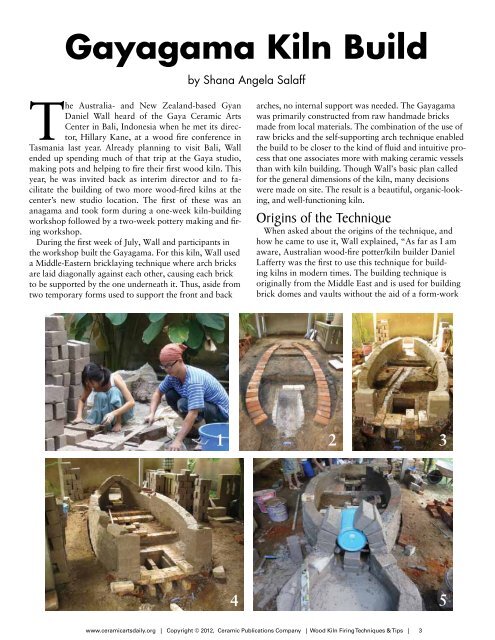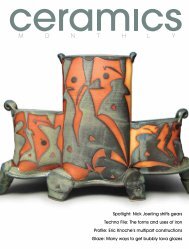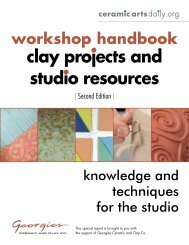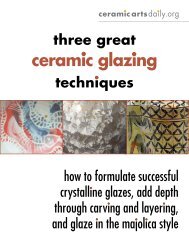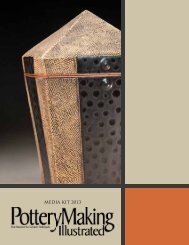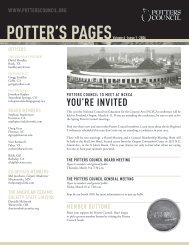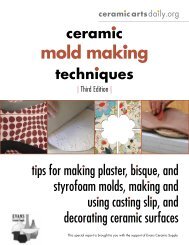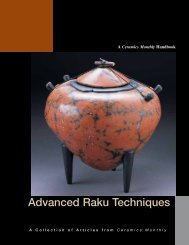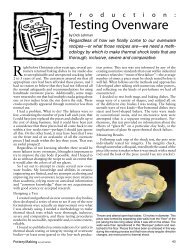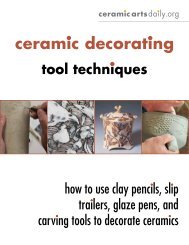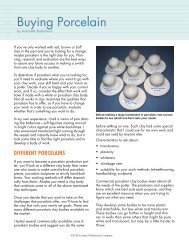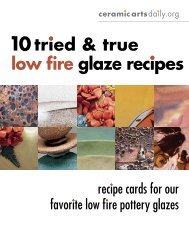wood kiln firing techniques & tips techniques & tips - Ceramic Arts ...
wood kiln firing techniques & tips techniques & tips - Ceramic Arts ...
wood kiln firing techniques & tips techniques & tips - Ceramic Arts ...
You also want an ePaper? Increase the reach of your titles
YUMPU automatically turns print PDFs into web optimized ePapers that Google loves.
Gayagama Kiln Build<br />
The Australia- and New Zealand-based Gyan<br />
Daniel Wall heard of the Gaya <strong>Ceramic</strong> <strong>Arts</strong><br />
Center in Bali, Indonesia when he met its director,<br />
Hillary Kane, at a <strong>wood</strong> fire conference in<br />
Tasmania last year. Already planning to visit Bali, Wall<br />
ended up spending much of that trip at the Gaya studio,<br />
making pots and helping to fire their first <strong>wood</strong> <strong>kiln</strong>. This<br />
year, he was invited back as interim director and to facilitate<br />
the building of two more <strong>wood</strong>-fired <strong>kiln</strong>s at the<br />
center’s new studio location. The first of these was an<br />
anagama and took form during a one-week <strong>kiln</strong>-building<br />
workshop followed by a two-week pottery making and <strong>firing</strong><br />
workshop.<br />
During the first week of July, Wall and participants in<br />
the workshop built the Gayagama. For this <strong>kiln</strong>, Wall used<br />
a Middle-Eastern bricklaying technique where arch bricks<br />
are laid diagonally against each other, causing each brick<br />
to be supported by the one underneath it. Thus, aside from<br />
two temporary forms used to support the front and back<br />
by Shana Angela Salaff<br />
1<br />
4<br />
arches, no internal support was needed. The Gayagama<br />
was primarily constructed from raw handmade bricks<br />
made from local materials. The combination of the use of<br />
raw bricks and the self-supporting arch technique enabled<br />
the build to be closer to the kind of fluid and intuitive process<br />
that one associates more with making ceramic vessels<br />
than with <strong>kiln</strong> building. Though Wall’s basic plan called<br />
for the general dimensions of the <strong>kiln</strong>, many decisions<br />
were made on site. The result is a beautiful, organic-looking,<br />
and well-functioning <strong>kiln</strong>.<br />
Origins of the Technique<br />
When asked about the origins of the technique, and<br />
how he came to use it, Wall explained, “As far as I am<br />
aware, Australian <strong>wood</strong>-fire potter/<strong>kiln</strong> builder Daniel<br />
Lafferty was the first to use this technique for building<br />
<strong>kiln</strong>s in modern times. The building technique is<br />
originally from the Middle East and is used for building<br />
brick domes and vaults without the aid of a form-work<br />
2 3<br />
www.ceramicartsdaily.org | Copyright © 2012, <strong>Ceramic</strong> Publications Company | Wood Kiln Firing Techniques & Tips | 3<br />
5


